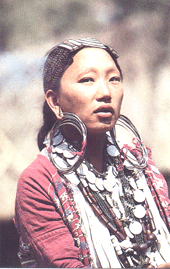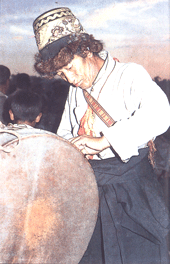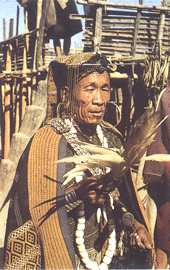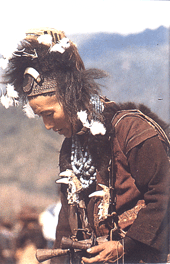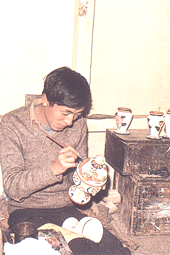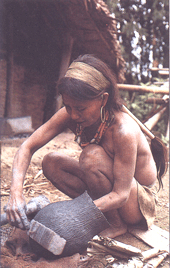|
Assam probably derives its name from Ahoms, the name of the dynasty that ruled there from the 13th to the early 19th century. It is the largest states in the northeast of India, whose capital, Guwahati, has an inspired location on the banks of the River Brahmaputra.
Assam, known in ancient lore as Kamarupa,
originally included in addition to modern Assam, parts of modern Bengal and Bangladesh. In the 13th century, the country was conquered by the Ahoms under Sukapha, a prince of the Shan tribe, in the upper Irravaddy valley.
Amidst Assam's verdant lushness are two important game sanctuaries, Manas and Kaziranga, both best known for one horned Indian rhinoceros, a species that faced extinction. Much of the rest of the state is devoted to tea plantations, which yield the strong Assam leaf popular all over the world.
General information
|
Population |
26, 638, 407
|
|
Area |
78,438 sq.
km |
|
Capital |
Dispur |
|
Languages Spoken |
Assamese (Bengali
for Barak Valley) |
|
District |
23 |
|
People Per Sq. km |
340 |
|
Literacy |
64.20% |
|
Best Season |
October to May |
Fairs and Festivals
Bohaag
The Bohaag Bihu marks the New Year at the advent of seeding time. Bohaag Bihu is also called the Rongaali Bihu or the Festival of Merriment
Bihu Festivals
Bhius the national festival of Assam is celebrated thrice a year. The Bihu festivals last for several days during which young people in the village may be seen moving around in groups gaily dressed or forming circles in the midst of the prettiest girls dance, singing songs of love and romance. The songs are composed in couplets that rhyme (and are almost always accompanied by a distinctive form of dancing), and each couplet depicts a different emotion. The language is simple and suggestive, and the style is neat and clear.
Maagh
Maagh Bihu marks the end of the harvesting period. Maagh Bihu is also called Bhogaali Bihu or the Festival of Food.
Kaati
Kaati Bihu marks the completion of sowing and transplanting of paddies. Kaati Bihu is also called Kongaali Bihu or the Festival of the Poor.
Tea Festival
The Tea festival organized by Assam Tourism in the month of November is a unique experience. One cannot miss this festival, which offers holidays combining visits to Tea Gardens, Golf and River Cruises. A visit to the "Guwahati Tea Auction Center" (GTAC) in Guwahati, the largest in India is a must.
Ambubasi Mela
This festival is organized every year during monsoon period at the Kamakhya temple of Guwahati. The fair attracts thousands of devotees from all over the nation. Ambubasi is closely related to the Tantrik rituals that are performed during this festival. The legend associated with the fair is that this period comes during menstrual cycle of Goddess Kamakhya. On the occasion, the temple remains close for first three days and devotees can worship the Goddess only on the fourth day.
Jonbeel Mela
Jonbeel of Jagiroad is host to one of the most spectacular and popular fairs in Assam. This is perhaps the only fair in India where barter system is still alive. A big market is organized during this fair and people from various tribes and communities exchange their products. But before the fair opens fire worship or Agni Puja is performed. Another interesting feature is that the King of Tiwa tribe collects taxes from his subjects. Colourful dances and music mark the fair. The whole atmosphere is swinging with fun and joy.
Baishagu
This festival is celebrated in the month of Baishakh. This festival is riot of colors and merriment. Baishagu begins with the worship of cow. Second day of the festival coincides with Bohag, first day of the Assamese almanac. It is from this day that the actual merriments start. Lord Shiva is worshipped. At the close of festival community prayer is offered at a particular place called 'Garjasali'.
Rajini Gabra & Harni Gabra
This is a religious practice before starting the new cultivation. The Dimasa tribe celebrates the festival. Rajini Gabra starts with Kunang or the village headman propitiating the family deity by closing the village gate on the Puja day. In the night, presiding deity is worshipped for protection and prosperity of the people. This function is called Harni Gabra. An interesting feature of this festival is that if any outsider enters the functions after the gates are closed, then the celebrations are considered spoiled and the intruder has to bear the cost of starting the functions afresh.
Dosa Thoi! Long Nai
This is an important religious dance performed at the 'Bathou Puja' or worshipping of their God-Shiva. In this dance the priestess called Deodhani dances with a bowel on her head in which the blood of a sacrificed fowl is kept. It is believed that while the Deodhani performs this dance in a condition of trance lord Bathou (Siva) will snatch away the bowel and drink the blood.
Ali-Ai-Ligang
This is a spring festival celebrated by the Mising tribe. This is one of the most colourful festivals of Assam. It is organized in the month of 'Ginmur Polo' (February-March) on the first Wednesday of the month. 'Ali' means root, 'Ai' means fruit and 'Ligang' means sow. Hence, it is festival, which initiates cultivation. Fish is essential in the feast and certain taboos like cutting trees, fishing; ploughing, burning jungles are strictly observed. Young boys and girls perform this dance.
Rongker and Chomangkan
This Mongoloid tribe migrated to this region several years ago. They celebrate two festivals Rongker and Chomangkan. Rongker is essentially a spring festival, which propitiates different God and Goddess for the welfare of village. The festival is organized to keep away diseases, natural calamities and of course for good harvest. On the other hand Chomangkan is an elaborate death ceremony. There is no fixed time for this ceremony and it is organized according to convenience of the community. This four day and four night ceremony is a must for every Karbis.
Art and Handicraft
Handloom weaving
The number of looms in the State stands at around eight lakhs, which works out to around 16 per cent of the looms in the entire Country. More than thirty thousand looms operate exclusively in silk. Cotton, muga, paat (mulberry silk) and endi are the basic raw materials for hand-woven fabrics in Assam.
Sualkuchi
It is the biggest center of silk production and weaving in the State. There are more than 3,000 weavers in and around the township. Sualkuchi is known as the Manchester of Assam.
Muga silk has a natural golden color and rare sheen that becomes more lustrous with every wash. Eri is a warm silk suitable for the winter. The designs used in Assam are mostly stylized symbols of animals, human figures, creepers, flowers, birds, channels, cross borders and the galaxy. Assamese weavers produce beautiful designs on the borders of traditional garments such as the mekhela-chaddar and riha and on the gamosa (towel) .The Laichangphi, produced traditionally by the weavers of Cachar district, are a popular quilt sought after because of its warmth and softness. The tribal make beautiful shawls.
Jewelry
Gold was available in many of the rivers flowing down from the Himalayas. In fact, a particular tribe of people, the Sonowal Kacharis, was engaged only in gold washing in these rivers.
The Assamese jeweler (sonari) makes exquisite lockets (doog-doogi, bana, jon-biri, dhol-biri) earrings (thuriya, loka-paro, keru), bracelets (gaam-kharu), necklaces (gal-pata), etc.
Cane and Bamboo
It is quite common all over and is used to make a variety of products. Cane furniture of Assam is much sought after both in the national and international markets.
Cane furniture Bamboo is used mostly to make domestic products such as chalani (sieve), kula (winnowing pan), khorahi (small basket), etc. The fancy bamboo japi (hat) with its colourful design and motif is worn by the Assamese peasant while working in the field.
The tradition of painting
In Assam tradition of painting can be traced back to several centuries in the past. The gifts presented to Hiuen Tsang and Harshavardhana by Kumar Bhaskara, the king of Kamrupa, included a number of paintings and painted objects, some done on exclusive Assam silk.
Assamese literatures of the medieval period abound in references to chitrakars and patuas who were expert painters. Ahom palaces and sattras and naamghars are replete with brightly coloured paintings depicting various stories and events from history and mythology.
Brass and Bell Metal
Brass is an important cottage industry with highest concentration in Hajo of Kamrup district. The Sarthebari area of the same district is well known for its bell metal craft. The principal items of brass are the kalah (water pot), sarai (a platter or tray mounted on a base), kahi (dish), bati (bowl), lota (water pot with a long neck) and tal (cymbals).
Gold, silver and copper too have formed part of traditional metal craft in Assam, and the State Museum in Guwahati has a rich collection of items made of these metals. Gold however is now used only for ornaments.
Ivory products
Such as combs, bangles, walking sticks and smoking pipes were made in the district of Barpeta. Their production has however been stopped since a ban was imposed on making and selling of ivory products as a conservation measure. Combs made of the horn of oxes are also a specialty.
Pottery
Practiced by two communities of artisans in Assam --- the Hira and the Kumar. The Hiras make household articles using the compression method. The Kumars use their potter’s wheel to make images for worship and clay dolls and toys. West Assam has long been proficient in the craft of terracotta. Asharkandi, a village in Goalpara district is famous for its graceful clay dolls.
Woodwork
It is an ancient Assamese craft. Exquisite woodcarvings are seen mostly on doors, walls, beams, ceilings and the splendid carved sinhasans used in prayer houses. Decorative panels in the royal Ahom palaces of the past and the 600-year old sattras or Vaisnavite monasteries are intricately carved in wood.
Kuhila Koth
Also known as fiber weaving is a famed handicraft of the Batadrava area of Nagaon district. Kuhila is woven on a simple loom-like gadget made of wood and bamboo poles to produce seats, mats and cushions. Kuhila craft is also an important cottage industry in the Gauripur area of Dhubri district in Lower Assam.
Pith or Indian cork has also been used for toy making since centuries in Assam. Such toys are chieflymade in the Goalpara region and they include figures of gods, animals and birds.
|

